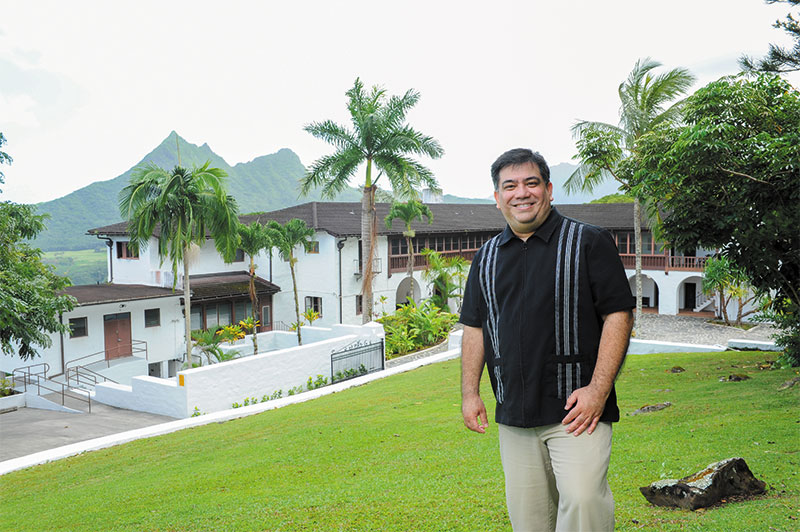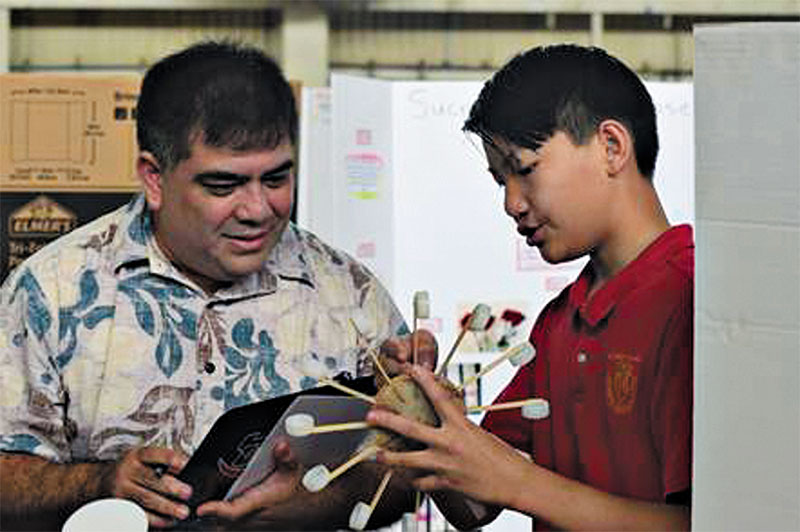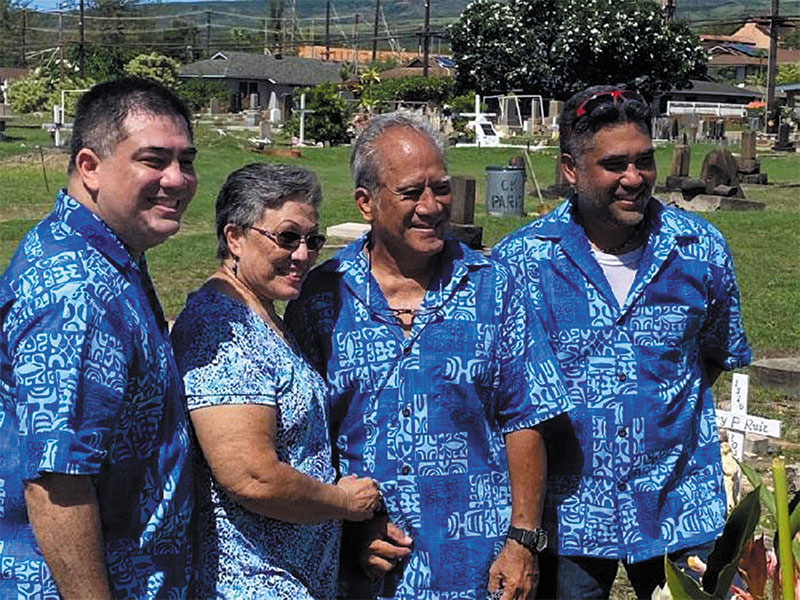Keeping the Faith

Heaven is never too far away for Dr. Llewellyn Young, superintendent of Hawai‘i Catholic Schools, whose office is located in the glorious surroundings of St. Stephen Diocesan Center, which is nestled in the Ko‘olau Mountain Range.
By relying upon faith and evidence-based science, Dr. Llewellyn Young, superintendent of Hawai‘i Catholic Schools, is confidently leading his flock through these challenging pandemic times.
Sometimes, even good shepherds need a little nudge when it comes to doing what is best for the entire flock.
Such is the case of Dr. Llewellyn Young, superintendent of Hawai‘i Catholic Schools and the man tasked with shepherding nearly 7,000 students in the islands, as well as about 800 teachers and administrators.
Just two short years ago, he was on the verge of declining an offer to serve as the schools’ associate superintendent, and his motives for doing so were understandable. As the principal of St. Joseph School at the time, Young had grown so fond of his little flock in Hilo that he simply did not want to leave. In fact, he even had plans to hang up the proverbial staff and settle down in the easternmost part of the Hawaiian Island chain once his working days were over.

Young, the former principal of St. Joseph School in Hilo, listens intently as student Cesar Rivera explains the nuances of his science fair project. PHOTO COURTESY DR. LLEWELLYN YOUNG
But the Lord moves in mysterious ways, and when former Hawai‘i Catholic Schools superintendent Dr. Michael Rockers gave him a little nudge, asking that he accept the offer because help was needed on campuses from Kekaha to Hilo, Young dutifully heeded the call.
“I have a love for Catholic schools. It is where my passion is,” he confesses. “So I said, ‘OK. I’ll go wherever the Lord takes me.’”
That path would ultimately lead to the full-time superintendent’s role in November after Honolulu diocese Bishop Larry Silva named Young as the successor to Rockers, who retired last summer.
The move turned out to be a godsend for the Catholic schools community, which has been a model in planning, preparation and perseverance during the pandemic. Much of the credit goes to Young and his ability to convince faithful followers that not only can they survive these challenging times together, but create safe environments where both students and educators can thrive, too.
Since August, almost all of the 33 Catholic schools in Hawai‘i have provided full-time in-person learning to students — with the exceptions being a couple of campuses still operating on a hybrid schedule. During this period, the schools have flourished under faculties empowered to come up with their own plans for curricula, methods of instruction and protocols to ensure healthy learning conditions. Among the safety measures they’ve religiously followed are daily home wellness checks, mandatory use of face masks and/ or face shields, no-touch temperature readings on campus, sanitization procedures at hand-washing stations, staggered arrival and dismissal times, and enhanced classroom ventilation. Many have even chosen to close their campuses to parents, visitors and guests to limit the threat of exposure.

Dr. Llewellyn Young (left) spends quality family time with mother Dianna, father Llewellyn Sr. and younger brother Robin during a visit to his hometown of Kekaha, Kaua‘i. PHOTO COURTESY DR. LLEWELLYN YOUNG
“When I look at what our schools have been able to accomplish in a relatively short period of time, and what they’ve been able to do, it’s remarkable,” observes Young. “They all created COVID response teams on their campuses, and they refined their plans specific to their campus community.”
Miraculously, only eight out of the thousands of preschool through grade 12 students have contracted the virus since the fall semester, and in each case, the student was found to have come in contact with the contagion off campus. Most importantly, established protocols successfully prevented the infected students from transferring the virus to classmates and instructors.
Young credits the low number of cases to the schools’ decision to follow evidence-based science, government recommendations and, of course, the tenets of their faith.
In his mind, real science and real faith always go hand in hand.
“We relied on the science — we did,” explains Young. “We looked at all of the information coming from the experts at the CDC (Centers for Disease Control and Prevention) and the state Department of Health, and followed, navigating our way through all the (guideline) changes. And it was changing — from day to day and week to week — and we changed with it.
“So, it’s been difficult at times, but the Lord has been our guide,” he continues. “We put our faith and trust in him, and we put our faith and trust in the science that follows.
“For us, using faith and science together in a harmonious way has been to our benefit.”
One of the unexpected results of the Catholic schools’ success has been a heaven-sent bump in admission numbers. Young estimates that more than 60% of the schools have seen an increase in enrollment for the spring semester.
“Parents talk to parents, so that was our marketing right there,” Young explains. “People would call and say, ‘Oh, we heard that you folks are offering in-person classes and that it’s working. We’d like to bring our kids over.’”
While obviously pleased with this development, Young is hopeful that the pairing of new students to Catholic school campuses is more than just a temporary solution.
“We do want them to come in and see everything else we do … see what’s special about our schools,” he says. “A big part of what we do is faith-based, and our faith has been a very integral part of our expression during the pandemic.”
That faith also means staying the course in the days ahead, even though some within the school system have suggested easing up on protocols.
“We don’t want our schools to let up,” Young states. “In fact, we want them to be even more diligent because as people, we see these rays of hope coming with the vaccines. So, we’re going to keep tightening our approach. After all, we want our communities and kids to be safe.”
Young hails from the west side of Kaua‘i, and is the eldest of two boys raised in a very devout Catholic home. Even to this day, his mother, Dianna, remains the parish secretary at St. Theresa Catholic School in Kekaha, while his father, Llewellyn Sr., continues to do anything that’s needed on campus, including maintenance.
“In his retirement, my dad still helps out at St. Theresa,” Young says. “They just built a brand-new church there and my father was in the middle of it all.”
Because of his parents’ background in entertainment, music and hula were part of the foundation of family life.
“My mother was a hula dancer and my father a fantastic ‘ukulele player who used to perform at the hotels. In fact, that’s how they met,” explains Young, who, despite his busy schedule as superintendent, still plays the organ and other instruments, dances hula and sings karaoke whenever time permits.
“Even though we don’t use music as much in our faith, it’s still a big part of me and my family,” he adds.
So, too, is speaking the language of locals.
“I come from Kekaha, and there we speak the harshest pidgin you can imagine!” he says with a chuckle. “Whenever we were away, my parents would tell my brother and I, ‘In the house, you speak pidgin. But outside, you need to speak good English.’”
Because his father was in the Air Force, Young spent many of his formative years living in places such as Michigan, South Carolina and Guam. Despite missing the islands terribly in his youth, he recognizes the benefits of living elsewhere.
“It really helped us in a way because we had to be adaptable,” he notes.
And being flexible remains a valuable skill to have in these times, he adds, particularly when helping thousands of students navigate a pandemic. Fortunately, he’s willing to do whatever it takes to be a guiding light for today’s youth.
“A lot of times, I don’t deal directly with them. I deal with their principals, their administrators, their teachers, their pastors. But at the end of the day, it’s all about them,” says Young, adding that he has sympathy for students growing up in times when customary practices such as attending proms and dances aren’t allowed.
“So I’m here to serve with the ultimate goal of empowering our principals, and making a powerful difference in the lives of our kids —‘cause heaven knows it’s tough being a kid today.”
No doubt. But it is much easier for the flock when a good shepherd is leading the way.





